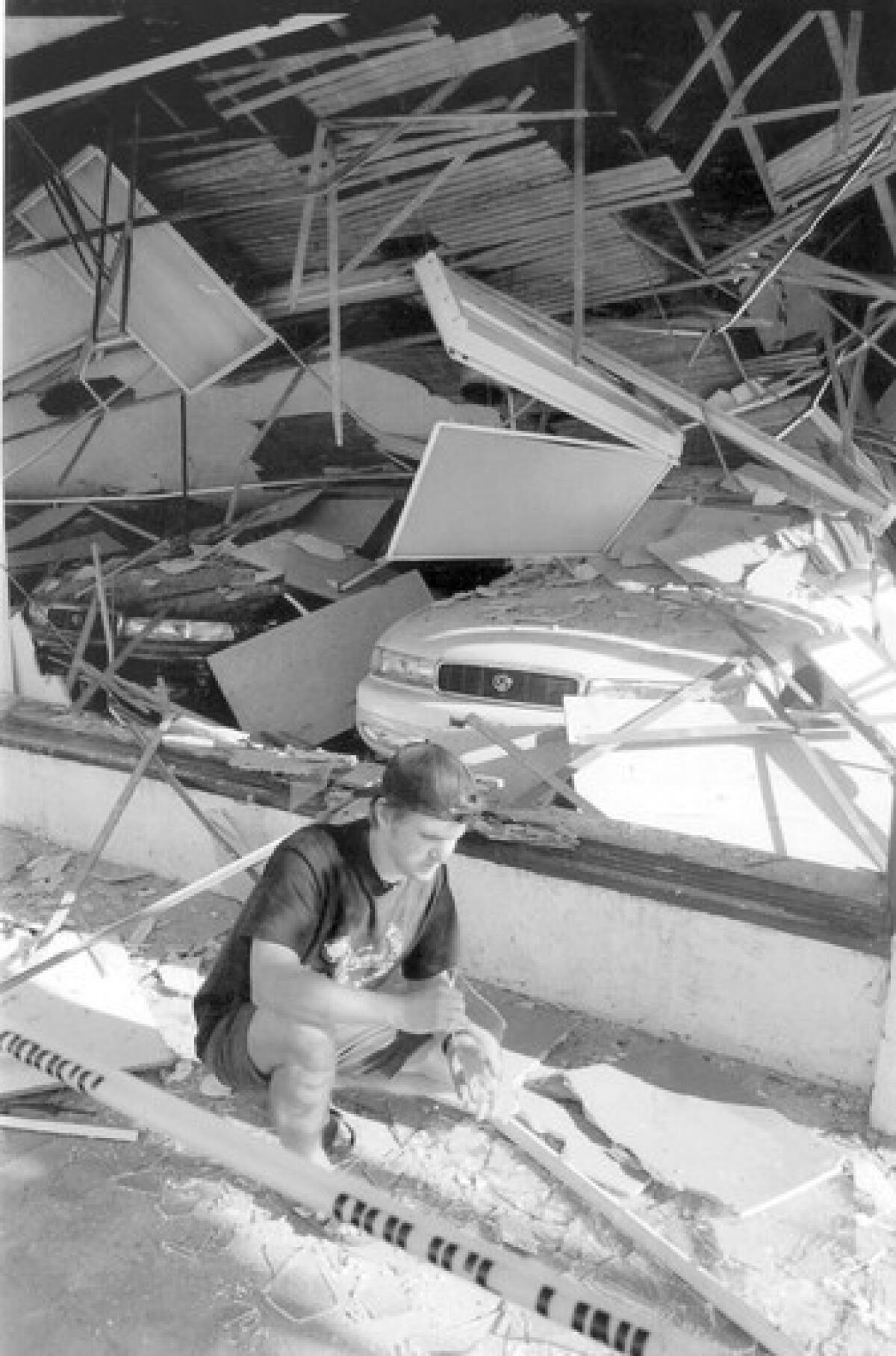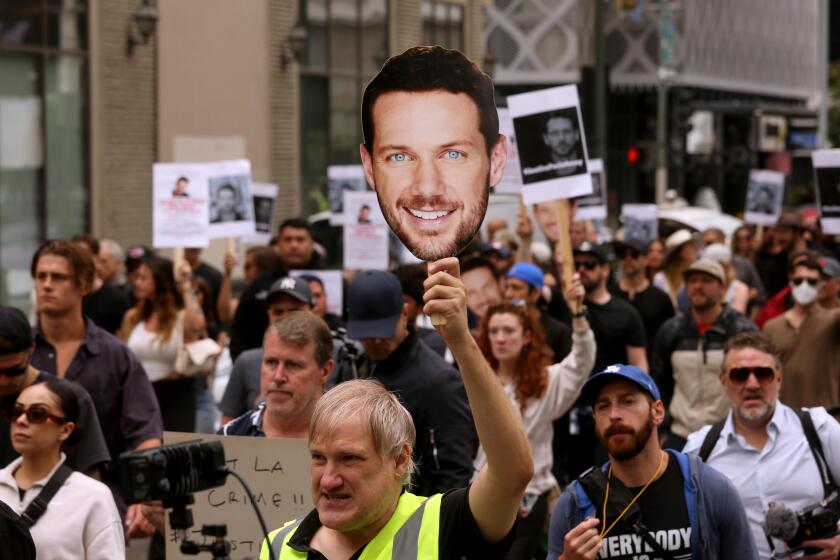Santa Monica offers L.A. a cautionary tale on quake vigilance

Amid the wreckage from the Northridge earthquake in 1994, no city took more decisive action than Santa Monica.
The City Council ordered its staff to find vulnerable wooden apartment and concrete buildings and require the owners to strengthen or demolish them. The city hired experts to help with the task. The council stood firm even when property owners protested the costs.
But as shock over the deadly earthquake faded, so did Santa Monica’s resolve. After several years of aggressive work, City Hall quietly stopped enforcing what were the strongest municipal quake regulations in California. Today, a top city official admits that he can’t even find the list that the city created of buildings that might be at risk.
“I would not say lost, but misplaced,” said Ron Takiguchi, the city’s building officer for the last three years. “At this time, I can’t locate it.”
Like Santa Monica, Long Beach is often cited as a leader in seismic safety regulations. In recent years, however, Long Beach, has also seen progress wane in identifying and fixing buildings.
Los Angeles officials are now considering their own inventory of so-called soft-story wooden buildings as well as concrete buildings, which seismic safety experts say pose the greatest risk of death in a major earthquake.
A Times analysis found more than 1,000 older concrete buildings in Los Angeles and hundreds more throughout the county that need to be checked to determine whether they could survive a major quake.
Soft-story buildings can pancake during shaking because the first floor is too weak to support the upper floors. In 1994, 16 people died when one Northridge apartment building collapsed. Concrete buildings are a risk because they are held up with brittle columns that can snap during shaking. In the 1971 Sylmar earthquake, dozens died when two concrete buildings fell.
Santa Monica and Long Beach show the challenges Los Angeles now faces in trying to develop a sustainable quake safety program.
::
The epicenter of the Northridge quake was 14 miles from Santa Monica, but the city was hit unusually hard.
About 1,500 apartments were lost — or roughly 5% of the city’s total stock. Some landmark buildings, including St. Monica Catholic Church and the 16-story concrete Champagne Towers on Ocean Avenue, were also badly damaged. The well-known Sea Castle apartment building had to be torn down.
“No one had expected Santa Monica would have serious damage in an earthquake,” former Mayor Judy Abdo said. “No one wanted to repeat that.”
Abdo and her colleagues on the City Council decided to start with decisive action — an ordinance that mandated retrofitting. They focused on the wooden apartment buildings, as well as older concrete and steel-frame buildings.
These measures were “the best pathway at getting the worst buildings retrofitted,” Abdo said. “I was a true believer. I did not want to see the Promenade fall down or any of the other buildings in town fall down. I didn’t want to see tenants having their units fall into their cars.”
Santa Monica decided to start by identifying potentially vulnerable buildings, and then demand that owners retrofit them. The original ordinance was passed soon after the 1994 Northridge earthquake, but officials added more detail in the ensuing years. Abdo recalls fielding many complaints from property owners, but she felt that the public wanted the safety measures.
“There was a sense of almost euphoria, in, ‘Let’s get together and deal with this,’” recalled John Jalili, the city manager at the time.
In 1998, Tim McCormick was hired away from Los Angeles’ building agency to oversee the retrofitting program.
Santa Monica initially identified about 70 potentially vulnerable concrete buildings, according to city reports reviewed by The Times. About 1 in 3 were residential buildings.
But the city never mailed notices to owners alerting them of the city’s findings, according to the reports.
It’s unclear how many soft-story wooden apartment buildings the city identified as being potentially vulnerable. But McCormick recalled that the number was about 2,000.
He said some property owners retrofitted soft-story buildings but others did not. Moreover, the older city seismic standards were not as strong as the one Santa Monica adopted in the late 1990s, McCormick said.
Santa Monica’s quake effort began to fade in early 2000s. First, Jalili — a major supporter of the campaign — retired in 1999. Then, the city’s seismic engineer left and was not replaced. McCormick left in 2007.
The city now enforces the law only when owners do remodeling and ask for construction permits, according to a 2005 city document. The document said there were an estimated 1,500 buildings of all types that would require mandatory seismic retrofitting work.
As for what happened to the list of vulnerable buildings that were identified when he was in charge, McCormick said, “It was there when I left.”
Jalili was stunned when The Times told him that the list could not be found.
“How could that be?” he asked.
City officials said the quake documents might have been misplaced when they scanned paper documents into digital form. Takiguchi, Santa Monica’s building official, said he is conducting a review of concrete and wooden soft-story buildings — even if that means redoing the work completed long ago.
“We are going to proceed because this is important,” he said.
::
Long Beach was also a onetime leader in seismic safety.
Haunted by the 1933 earthquake that damaged large swaths of the city, Long Beach became one of the first cities to force owners to retrofit or demolish dangerous brick buildings. The city recently completed the effort, which involved retrofitting or demolishing more than 900 buildings.
The law became a model for Los Angeles and other cities around the state. The momentum led California legislators to pass a law requiring many local governments to identify brick buildings.
In 2008, during the 75th anniversary of the 1933 earthquake, Long Beach officials talked about a new campaign: Retrofitting wooden apartment buildings.
“We’d like to do an inventory of these buildings to see how many are out there, and go from there on what we can do to make them safer,” then-Superintendent of Building and Safety Larry Brugger told the Long Beach Press-Telegram in 2008.
Brugger said in a recent interview with The Times that the city didn’t follow through on the soft-story list.
“In my ideal world, all buildings would be seismically safe,” said Brugger, who retired in 2010. “Definitely, I would have liked to have seen more emphasis on that.”
Angela Reynolds, deputy director of Long Beach’s Building and Safety Bureau, said she is proud of the city’s record on seismic retrofitting, and she noted that a few concrete buildings have been strengthened as part of recent downtown loft conversions.
Reynolds said there has been no plan to repeat Long Beach’s program on brick buildings with concrete and wood structures unless it is requested by the state.
More to Read
Sign up for Essential California
The most important California stories and recommendations in your inbox every morning.
You may occasionally receive promotional content from the Los Angeles Times.













